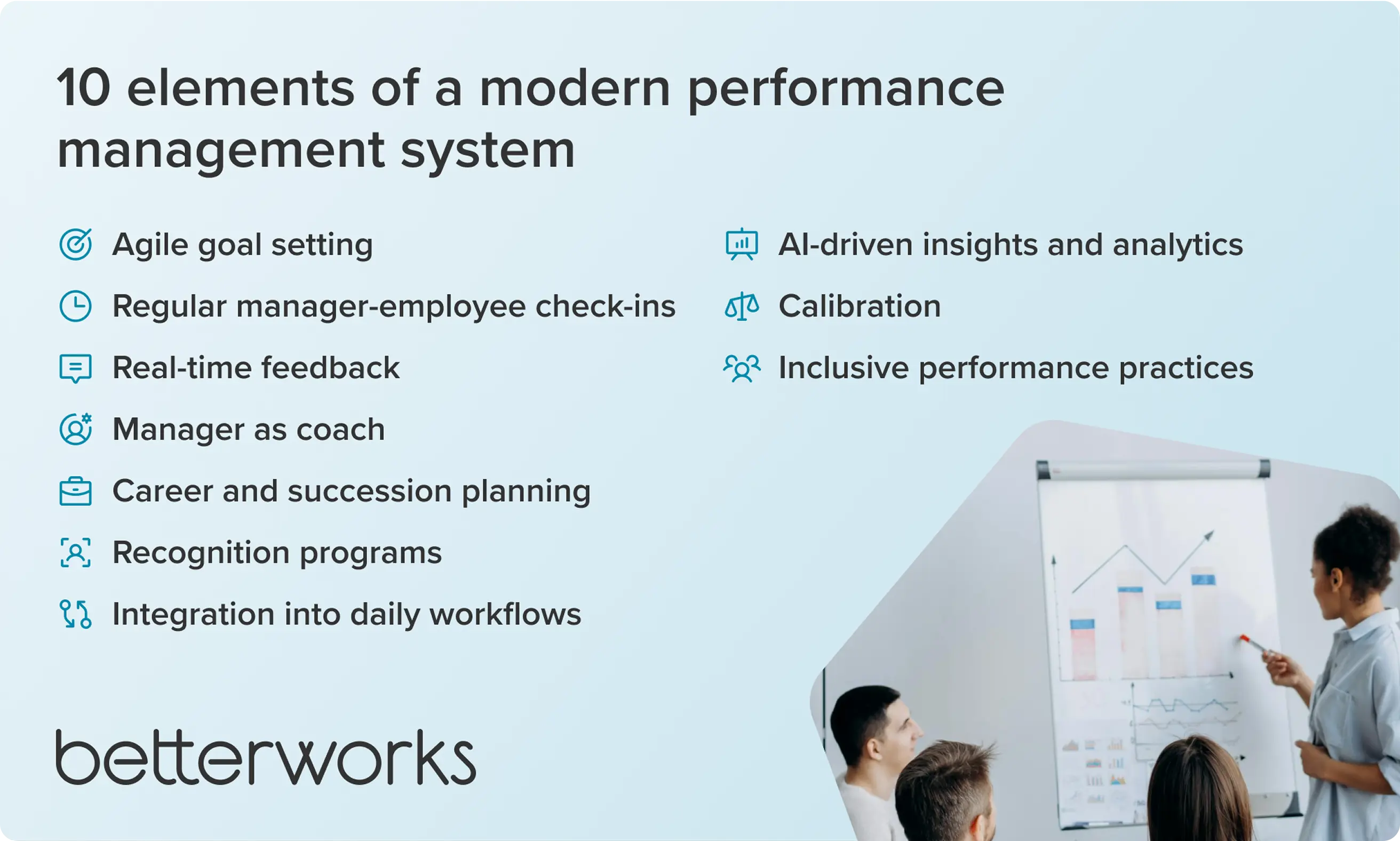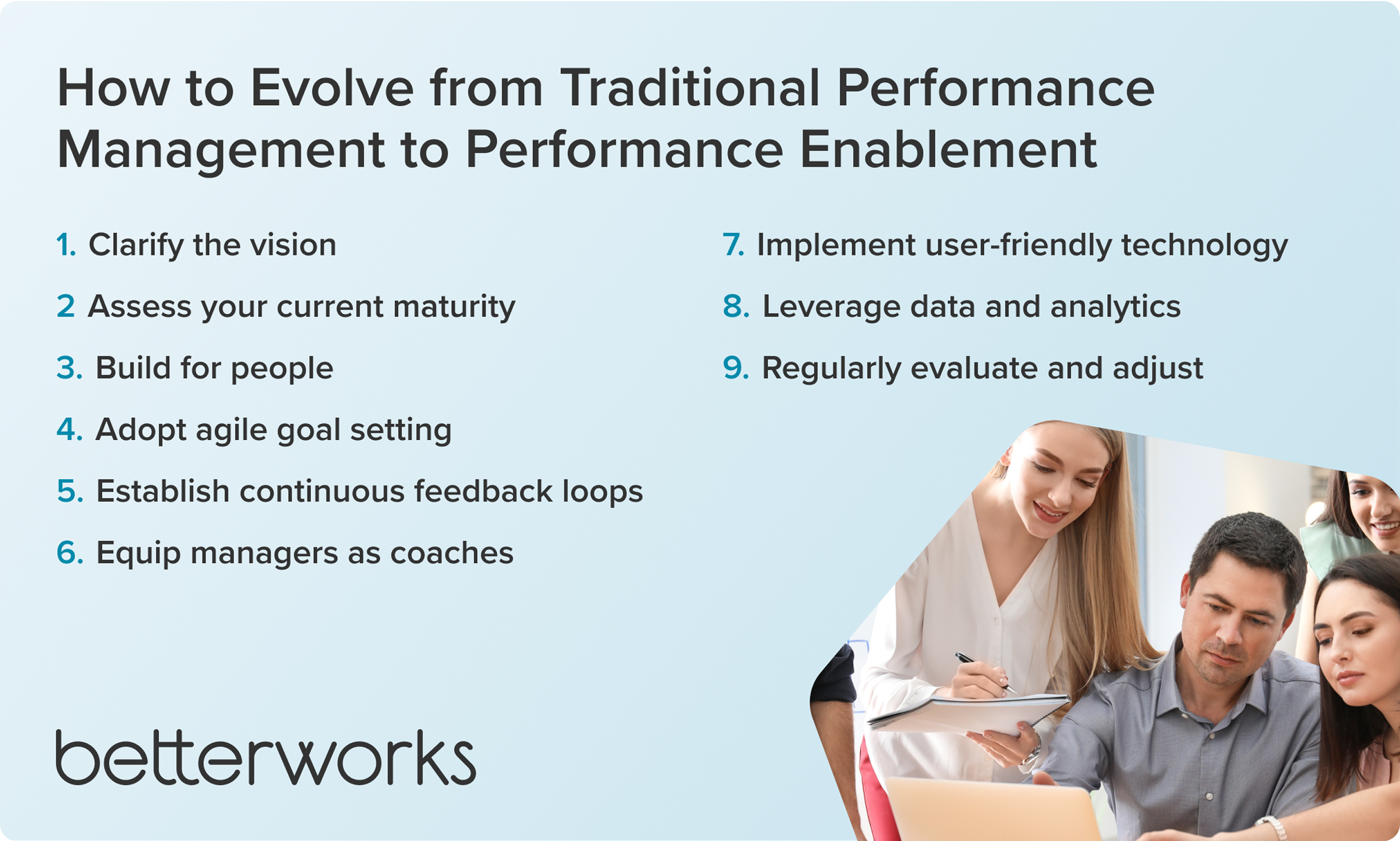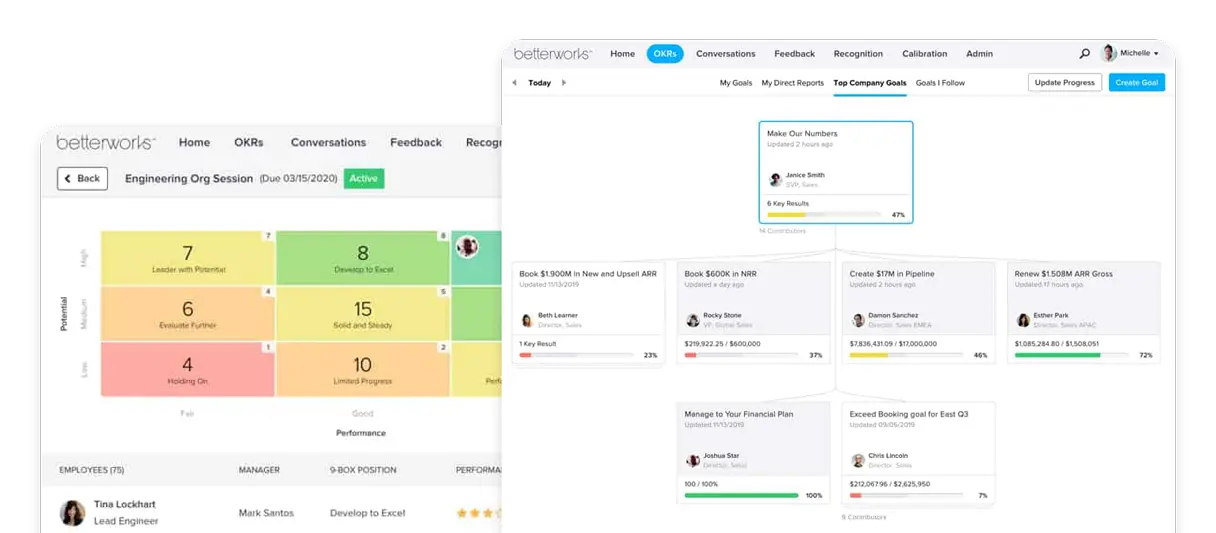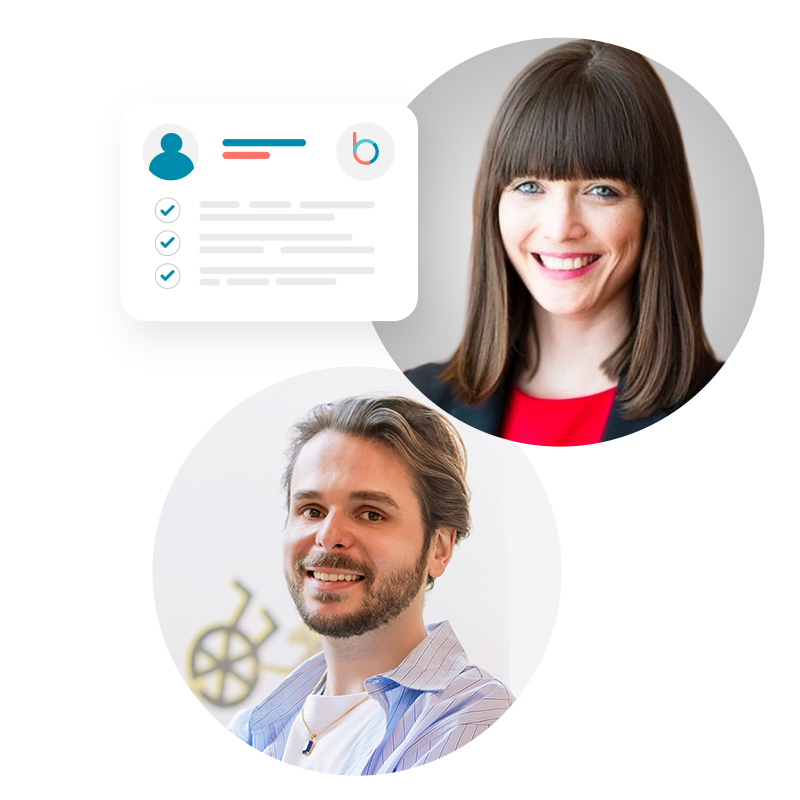Performance Management: New Rules for the Agile Enterprise


State of Performance Enablement 2025
AI and the Employee Experience
Read the ReportAnnual performance reviews are no match for the demands of today’s agile workplace. Even organizations already using continuous performance management are exploring ways to further optimize their approach.
Let’s take a deep dive into what performance management means today, where it’s headed next, and how enterprise HR leaders are successfully evolving their practices to enhance agility, alignment, and employee engagement.
What is performance management?
Performance management has long been a foundational practice for organizations seeking to optimize employee performance and achieve business objectives. While traditionally anchored in structured annual evaluations and formal feedback sessions, its role continues to evolve significantly as workplace dynamics and employee expectations shift.

Performance management definition
Performance management is the ongoing practice of aligning employee goals, feedback, performance assessments, and development opportunities with strategic business objectives.Performance enablement vs. performance management
Traditional performance management stages typically include fixed annual goals, mid-year check-ins, formal year-end evaluations, and compensation decisions based primarily on these periodic reviews. This approach often fails to respond effectively to rapid organizational changes and individual development needs.
In contrast, performance enablement is a modern, dynamic approach characterized by flexible goal setting, real-time feedback, and ongoing coaching. It integrates performance discussions into everyday work, allowing employees and managers to address performance proactively and adaptively, driving greater engagement, alignment, and continuous improvement.
Performance management benefits for business strategy and performance
Effective performance management aligns individual employee goals with organizational objectives, creating a cohesive strategy for success. This alignment clarifies expectations, enhances productivity, and fosters accountability.
Goal alignment across teams
When employees understand their roles in achieving company goals, motivation and efficiency improve, maximizing productivity and ensuring strategic alignment.
Increased employee engagement, retention, and achievement
Continuous feedback and clear career paths increase employee satisfaction, retention, and achievement by creating a transparent and supportive environment.
Stronger manager-employee relationships
Regular check-ins and coaching foster trust and collaboration, significantly improving morale and performance by providing clarity and encouraging mutual respect.
Better decision-making through analytics
Analytics integrated into performance management deliver actionable insights, enabling informed strategic decisions, addressing issues promptly, and optimizing performance.Higher productivity and business impact
Organizations with effective performance management are more productive and financially successful, demonstrating clear benefits in competitive advantage and productivity gains.
Companies focusing on effective performance management
McKinsey & Company
In the spotlight: Performance management that puts people first

Why traditional performance management fails modern teams
Traditional performance management methods fail to meet modern teams’ dynamic needs, resulting in disconnected goals, employee disengagement, and limited development.
It looks backward, not forward
Traditional reviews are often compliance-driven reflections on the past — not forward-looking tools for growth. They’re too static to drive meaningful improvement or move the business forward.Goals quickly become irrelevant
Annual goals don’t mean much when priorities are shifting quickly. When goals go stale, employees lose focus and motivation, and teams drift from what matters most.
Feedback is infrequent and comes too late
When feedback only comes once or twice a year, it loses impact. It often feels punitive, arrives too late to change outcomes, and limits growth in real time.Managers act as evaluators, not coaches
Traditional performance evaluations emphasize judgment rather than growth. The use of performance management bell curves often forces managers to rank employees by rigid criteria, which can demoralize high performers and undermine collaboration.
The process is prone to bias
Without regular check-ins or clear criteria, reviews become more subjective. It’s easy for bias to creep in, undermining fairness and credibility.
Employees feel disengaged and disempowered
Limited transparency and infrequent interactions create disengagement, reducing motivation, retention, and performance.
Systems are hard to use
Legacy performance management tools are often hard to navigate and poorly integrated into the other tools that employees rely on to do their jobs. When systems are frustrating, adoption suffers, and so does performance.
Toward a new model for employee performance
| Performance Management | Performance Enablement |
|---|---|
| Annual goals | Agile, quarterly goals |
| Infrequent reviews | Ongoing check-ins |
| Manager as evaluator | Manager as coach |
| Ratings-driven | Growth- and feedback-driven |
| Siloed processes | Embedded in daily work |
| Performance Management |
|---|
| Annual goals |
| Infrequent reviews |
| Manager as evaluator |
| Ratings-driven |
| Siloed processes |
| Performance Enablement |
|---|
| Agile, quarterly goals |
| Ongoing check-ins |
| Manager as coach |
| Growth- and feedback-driven |
| Embedded in daily work |
10 elements of a modern performance management system
A successful modern performance management system includes essential components designed to support ongoing employee development, enhance organizational agility, and drive sustainable performance.
Agile goal setting
Clearly defined, flexible goals keep employees aligned with strategic priorities while giving teams the agility to adapt as business needs evolve. These goals make individual contributions clear and meaningful.Regular manager-employee check-ins
Frequent, structured conversations enhance trust, clarify expectations, and provide ongoing support.
Real-time feedback
Immediate, actionable feedback from managers and even peers allows quick performance adjustments and continuous improvement, while also improving collaboration.Manager as coach
Managers adopt coaching behaviors to proactively foster employee development, facilitating continuous learning and growth.
Career and succession planning
Structured conversations about skills, career aspirations, and succession readiness keep employees motivated and prepared for future roles.Recognition programs
Timely and consistent recognition boosts morale, reinforces positive behaviors, and motivates sustained high performance.
Integration into daily workflows
Continuous performance management processes seamlessly embedded in daily tasks improve usability, adoption, and effectiveness. A streamlined performance management workflow supports agility, unlocks manager potential, and keeps employees focused and connected, increasing engagement and reducing administrative burden
AI-driven insights and analytics
AI in performance management helps to simplify goal-setting, feedback, and reviews to improve decision-making and reduce bias. Advanced analytics helps HR spot trends and trouble spots, proactively improving talent management.
Calibration
Automated performance management calibration ensures fair, consistent, and transparent performance evaluations across teams and streamlines the process for HR and managers.Inclusive performance practices
Prioritizing diversity, equity, and inclusion in performance practices ensures equitable opportunities and fosters innovation and morale.

How to evolve from traditional performance management to performance enablement
Transitioning from traditional performance management to performance enablement involves strategic planning, clear communication, and consistent execution. Here’s a step-by-step approach to making the successful shift.

Clarify the vision
Clearly articulate and communicate the reasons for the shift to performance enablement. Explain the benefits, such as increased agility, improved employee engagement, and better alignment with strategic goals, to gain buy-in from all stakeholders.Assess your current maturity
Before changing processes, assess where you stand today. Evaluate your current performance management approach across such areas as strategy alignment, feedback culture, technology, and manager capabilities. This gives you a baseline from which to track progress and identify where to focus first.Build for people
Use design thinking principles to create a performance management process that enriches employee experiences and outcomes.Adopt agile goal setting
Replace annual goal-setting processes with quarterly or ongoing objectives using frameworks such as Objectives and Key Results (OKRs). Ensure goals are agile, clearly defined, measurable, and aligned with changing business priorities.
Establish continuous feedback loops
Create a culture of continuous feedback by training managers and employees to provide frequent, actionable insights. Use regular check-ins to foster ongoing dialogue, address challenges promptly, and reinforce positive behaviors.
Equip managers as coaches
Transition manager roles from evaluators to coaches by providing training in coaching techniques. Equip them to support employee growth and performance improvement through regular, constructive, and developmental conversations.
Implement user-friendly technology
Adopt intuitive, user-friendly performance management platforms that seamlessly integrate with daily workflows. Such technology should facilitate continuous feedback, agile goal setting, and real-time performance tracking.
Leverage data and analytics
Integrate robust analytics into your performance management approach to gain deeper insights. Use data-driven insights to make informed decisions, identifying areas for improvement and optimizing employee and organizational performance.Regularly evaluate and adjust
Continuously monitor, evaluate, and adjust your performance enablement practices based on employee feedback, engagement data, and performance outcomes.
Real-world examples: How leading organizations are reimagining performance management
Check out these examples of organizations that have effectively implemented continuous, agile performance practices, transforming their organizational performance and employee experience:

Ferrer: boosting engagement and agility
When traditional performance reviews became too rigid and compliance-driven, Ferrer embraced continuous feedback, manager empowerment, and personalized growth paths. Learn how shifting from control to trust transformed their workplace culture and sparked meaningful employee development.
Read more about Ferrer’s transformation

HelloFresh: accelerating global growth
When rapid growth challenged HelloFresh’s decentralized HR approach, the HelloFresh HR team led a strategic shift toward unified processes and global scalability. Learn how thoughtful design, cross-functional collaboration, and emphasis on adoption were key to their successful transformation.
Learn how HelloFresh successfully transformed its HR strategy

LivePerson: Unlocking talent with AI and real-time feedback
LivePerson faced the challenge of adapting its performance processes to match its innovative and fast-paced environment. By embedding performance management directly into daily workflows, leveraging AI-driven insights, and fostering ongoing feedback, LivePerson created a transparent, engaged, and high-performing workforce. This approach unlocked talent potential, significantly improving productivity and employee satisfaction.
Discover how LivePerson harnessed AI to transform performance

How Betterworks makes performance enablement easy for the enterprise
To successfully implement performance enablement across an organization, choosing the right tools and systems is essential. Betterworks provides a comprehensive, intuitive, and powerful platform designed specifically to support continuous performance enablement at scale, making it easy for enterprises to shift from traditional methods to a modern, agile approach.
Unified platform for goals, feedback, and development
Betterworks integrates goal-setting, continuous feedback, and employee development into a single, seamless experience. This unified platform ensures clarity and consistency across all aspects of performance, simplifying management tasks while empowering employees.
Manager-friendly workflows
Managers benefit from streamlined, user-friendly workflows that make regular check-ins, coaching sessions, and performance assessments easier and more effective. By simplifying these crucial tasks, managers can focus more on meaningful conversations and less on administrative processes.
Employee-focused design
The Betterworks platform prioritizes employee experience by being intuitive, accessible, and easy to use. Employees can effortlessly track goals, receive and provide feedback, and engage in ongoing developmental discussions, boosting their overall productivity and satisfaction.Built-in analytics and mobile-ready tools
With built-in analytics, organizations gain real-time insights into performance trends, skill gaps, and employee engagement, enabling proactive and informed decision-making. Mobile-ready functionality ensures these powerful insights and tools are accessible anytime and anywhere, meeting employees where they work.
AI-enabled tools to simplify and accelerate performance management
Betterworks leverages advanced AI to simplify complex tasks such as goal alignment, feedback collection, and bias mitigation in reviews. AI-driven insights help leaders and managers swiftly identify areas for improvement, streamline decision-making processes, and ensure fair, consistent, and objective evaluations across the enterprise.
By choosing Betterworks, enterprises can effortlessly transition to continuous performance enablement, fostering a culture of agility, transparency, and ongoing employee development.
The future of performance management
The future of performance management is here — and it’s agile, continuous, and people-first. Real-time insights, AI-powered analytics, and coaching-centered leadership are transforming how organizations approach performance. By embracing this modern model, you can create highly engaged, resilient, and empowered teams ready to adapt and thrive, no matter how fast the business landscape evolves.
See how industry leaders are successfully making the shift to performance enablement — and discover how your organization can achieve similar results.


Transform your performance management today
Ready to unlock your team’s full potential? Get the Betterworks State of Performance Enablement Report now and learn exactly how to drive meaningful, measurable improvements in your organization.
Frequently Asked Questions About Performance Management for Enterprise Organizations
How can performance management align with our company’s mission, vision, and strategy?
Effective performance management connects daily work with long-term strategy. When performance goals cascade from the top down and stay visible across the organization, employees can clearly see how their individual goals should ladder up and how their performance contributes to broader outcomes. Modern systems support this alignment with tools that adjust in real time, even as priorities shift.
What outcomes should performance management drive and how can we measure them?
At its best, performance management drives both business success and professional development. Key performance indicators, such as engagement, productivity, innovation, and retention, can reflect whether your approach supports both top performers and those still growing. Measuring these outcomes in connection with performance goals and feedback ensures you’re tracking meaningful progress.
How do we know if employees are actually growing and developing?
Development shouldn’t be left to assumption. Career development becomes more effective when learning goals and development plans are part of ongoing conversations. When progress is measured over time, organizations can surface real, measurable performance growth.
What helps make performance management more equitable and inclusive?
Structure is key. When human resources teams use consistent criteria, gather input from multiple sources, and rely on data-informed calibration, the performance management cycle becomes more equitable. This approach helps reduce bias and ensures development opportunities are accessible to all.
How can we make performance assessments more objective?
Objectivity comes from multiple perspectives and standardization. Traditional, manager-only annual reviews can overlook context or carry bias. Incorporating self-assessments, peer feedback, and structured evaluations creates a more complete and fair view of individual performance.
How can we tell if performance management is helping the business?
It helps to link individual performance and development plans to strategic business metrics, such as revenue growth, customer satisfaction, or employee retention. When those connections are clear, it’s easier to assess whether your performance management system is enabling success or simply fulfilling compliance. That’s what makes performance management important—not just as a process, but as a driver of impact.
How can we identify and address performance issues fairly?
Early visibility matters. When check-ins and goal-tracking happen frequently, managers can spot both development needs and emerging strengths. A structured performance management cycle enables timely coaching, fair assessments, and forward-looking development plans.
How does performance management work best with remote or hybrid teams?
Flexibility is essential. Today’s teams rely on asynchronous conversations, cross-functional collaboration, and adaptable goals. Performance management systems must support these dynamics with tools that enable check-ins, feedback, and goal alignment across time zones and team structures.
How can we keep our performance program current as our organization changes?
Performance management is not static. Regular reviews of your approach — benchmarking against peers, incorporating employee feedback, and aligning with evolving business needs — help keep your program relevant. A modern system makes it easier to evolve your cycle alongside strategy shifts and workforce trends.
You Might Find Interesting
Ready to Unlock Your Team’s True Potential?




